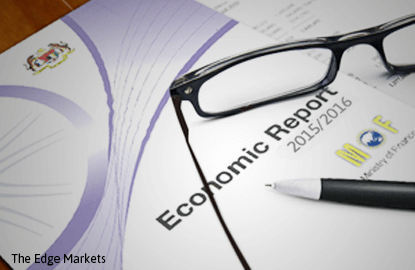
This article first appeared in The Edge Malaysia Weekly, on October 26 - November 1, 2015.
Malaysia’s gross domestic product (GDP) is projected to expand at a slower rate of 4% to 5% in 2016, below the 5.3% it grew in the first half of this year. But it remains on track to grow at least 4.5% in 2015, according to the Economic Report 2015/16 released by the Ministry of Finance (MoF).
Unsurprisingly, the slower growth projection for next year took into account the myriad uncertainties surrounding the country’s economy, from slower global economic growth (particularly in China) and continued weakness in commodity prices to the volatility in financial markets and the depreciating emerging market currencies.

In January this year, a precipitous fall in oil prices forced growth targets to be revised downwards from the 5% to 6% targeted when Budget 2015 was tabled in October last year. Malaysia is on track to achieve the revised growth target of 4.5% to 5.5%, Prime Minister Datuk Seri Najib Razak says in the preface of the report.
While domestic demand will continue to drive growth next year, private sector spending — its growth anchor — is expected to moderate to 6.4% of GDP next year, thus pulling down domestic demand growth to 5.5%.
In fact, all components of domestic demand are expected to moderate next year, except for public investment because of the pipeline of infrastructure projects planned under the 11th Malaysia Plan (2016-2020).
Private investments are projected to contribute to 6.7% of GDP, down from 7.3% in 2015, with most investments in the manufacturing and services sector. MoF expects to see an increase in high-value-added investments in the manufacturing sector and capital spending in the services sector following the government’s measures to revitalise and modernise the services sector.
Malaysia attracted net foreign direct investment inflows of RM22.4 billion for the first six months of this year — about RM4.5 billion more than a year ago — with investments channelled into the manufacturing, mining and quarrying, and services sectors.
Private consumption is expected to expand to 6.4% of GDP, lower than the 6.8% seen in 2015. The report states that private consumption will benefit from “stable employment prospects and favourable wage growth”. Easy access to credit, Bantuan Rakyat 1Malaysia cash transfers, accommodative interest rates and benign inflation will lend support to private consumption spending, the report adds.
Whether projections of private investment and consumption are overly sanguine will be closely watched in the coming months, even as global uncertainties nudge more companies into conservative mode. News of layoffs and a freeze in hiring have been cropping up in recent months and the year ahead could see more downsizing in companies as economic growth slows further, economists say, potentially hitting the 6.4% projected private consumption growth.
“The government is still on the bullish side with regards to private consumption. The risk here is that consumer spending might not be as strong as they expect. Even though the headline inflation looks benign, the underlying inflation pressure is strong. Furthermore, the ringgit has depreciated sharply against other currencies and consumers tend to tighten their belts when this happens,” says RHB Research Institute economist Peck Boon Soon.

Even so, public expenditure is expected to grow 2.7% in 2016, 0.1% lower than in 2015, as public consumption growth moderates to 3%. Public investment, however, is expected to increase to 2.3%, on the back of new projects under the Economic Transformation Programme and the 11th Malaysia Plan, alongside existing projects under the 10th Malaysia Plan.
On the external front, exports are forecast to grow at a sluggish 0.9% of GDP next year, a rebound from the contraction in 2015. Gross exports are expected to increase by 1.4% to RM770.43 billion in 2016 as demand for manufactured exports, particularly in the electrical and electronics sector, rises.
Imports will grow stronger to 1.5% of GDP, as gross imports should expand by 3.3% to RM697.23 billion in 2016, supported by public investment and capital spending in the manufacturing and services sector.
As import growth outpaces exports, the trade surplus is projected to shrink to RM73.2 billion or 5.9% of GDP in 2016.
On the supply side, the majority of the economic sectors is projected to see a slowdown in growth, except for the agricultural sector — which is expected to remain flat at 1.3% of GDP — and the mining sector, which is forecast to expand by 4% next year.
Growth in the mining sector will be supported by a 5.1% increase in natural gas production to 6,750 mmscfd, from the commencement of the floating liquefied natural gas project in Sarawak. Natural gas output is also expected to increase as the Train 9 LNG facility goes into full operation in early 2016.
The services sector, which accounts for more than half of total GDP, is anticipated to grow at a slower rate of 5.4% in 2016 compared with 5.7% in the previous year. According to the MoF, all subsectors are expected to expand.
The manufacturing sector will also see slower growth of 4.3% of GDP going forward while construction sector growth is expected to decline 0.4% year on year to 8.4% of GDP in 2016.
The construction sector will be largely driven by infrastructure projects such as the Pan-Borneo Highway, MRT Line 2 and Pengerang Integrated Petroleum Complex project.
All that should help Malaysia remain on “a steady growth path” next year, the MoF says, even as the world braces for greater challenges amid continued global volatility that could further dampen domestic demand.
Save by subscribing to us for your print and/or digital copy.
P/S: The Edge is also available on Apple's AppStore and Androids' Google Play.